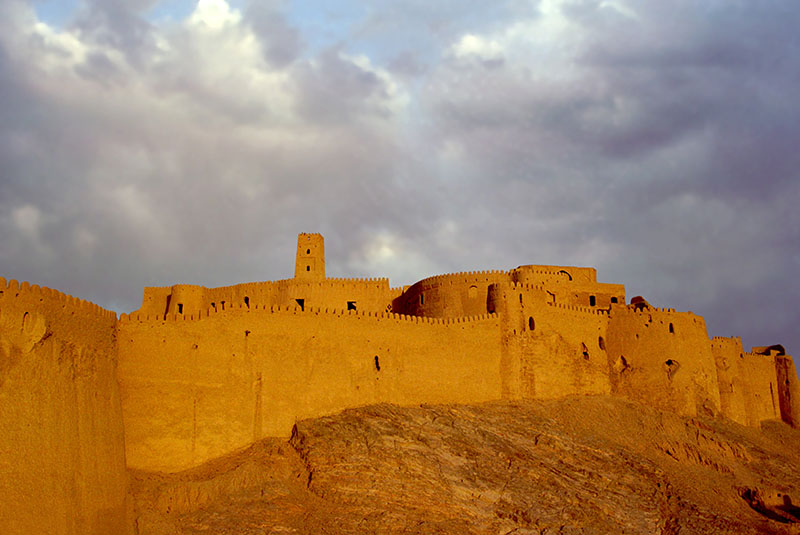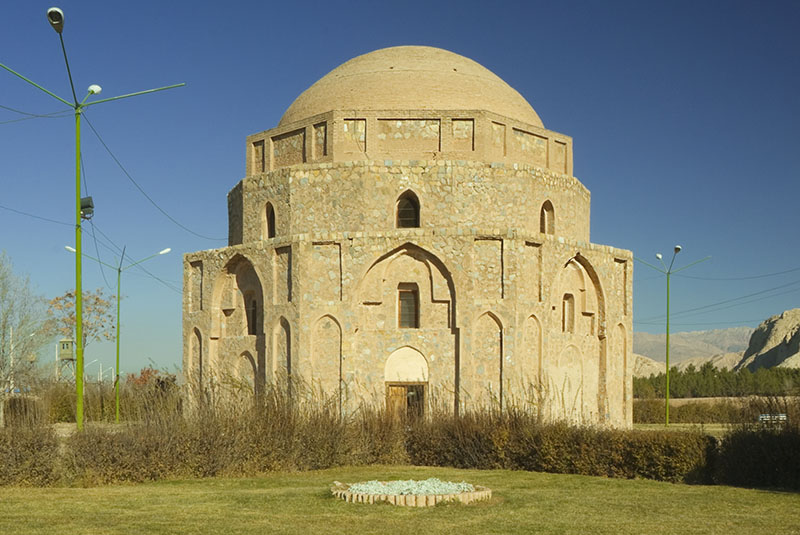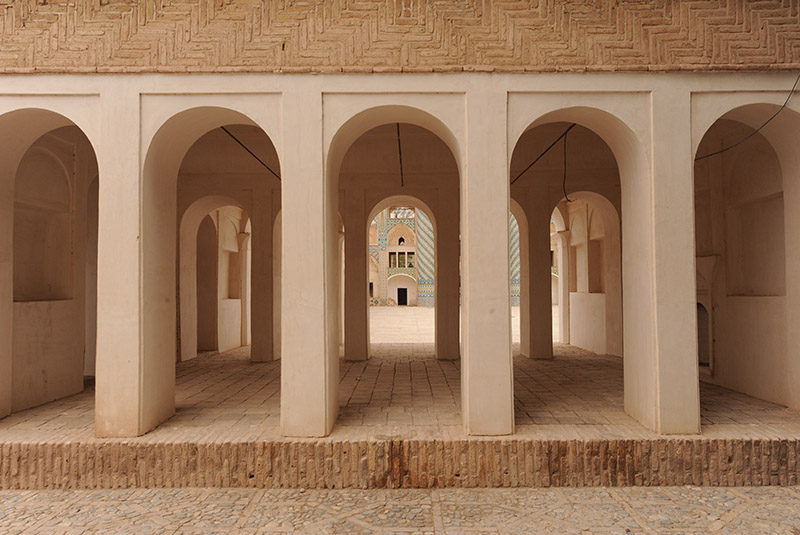Kerman Tourist Attractions
The Historic Ganjali Khan Complex in Kerman
The Ganjali Khan Complex, a masterpiece of Safavid-era architecture, combines a bathhouse, bazaar, and mosque, reflecting the grandeur of Kerman's historical heritage.
Read moreShah Nematollah Vali Shrine: A Must-Visit Site in Kerman
Shah Nematollah Vali was the founder of the Nematollahi order in Sufism, leaving behind a significant body of work. His final resting place is in Mahan, Kerman, where he was buried after his death in 1431.
Read moreKerman’s Jameh Mosque: History, Architecture & Visitor Guide
Kerman's Jameh Mosque, with its stunning blue-tiled minarets and intricate brickwork, stands as a timeless symbol of Persian architecture and cultural heritage.
Read moreBagh-e Sangi | Iran’s Unique Stone Garden in Sirjan
Bagh-e Sangi in Sirjan stands out as a unique site, featuring an intriguing display of stones suspended from the branches of withered trees.
Read moreRayen Castle: Iran's Ancient Desert Fortress
Rayen Castle, located in the town of Rayen in Kerman Province, Iran, is a remarkable example of ancient Persian architecture.
Read moreJabalieh Dome in Kerman: History, Architecture & Visitor’s Guide
The Jabalieh Dome or Gabri Dome, also known as Rock Dome, a stone structure with an octagonal base, is one of the most enigmatic and striking buildings in Kerman, Iran.
Read moreFat'h Abad Garden in Kerman | History and Architectural Beauty
Fat'h Abad Garden, located just outside the city of Kerman, is one of the region's most celebrated historical landmarks. Built during the Qajar dynasty in the 19th century, the garden originally served as a summer retreat for local governors, offering a peaceful escape from the city's desert climate.
Read moreKeshit Waterfall | A Desert Oasis in Kerman, Iran
Kerman is a province that never ceases to amaze its visitors, with breathtaking spots at every turn. One of the most extraordinary natural attractions in this region is the Keshit Waterfall.
Read moreShahdad's Kalut | The Hottest Place on Earth
Did you know that one of the hottest place on Earth is found in Iran? The Shahdad’s Kalut area holds this distinction and stands out as one of Iran's most unique and famous attractions. This remarkable location is perfect for adventure seekers and desert trekkers.
Read moreMeymand Rocky Village: A Photographer's Dream
Located in the arid mountainous area of Kerman Province near Shahr-e Babak city, the Meymand Rocky Village is one of the few hand-dug rocky villages that still exist!
Read moreArg-e Bam: The Fascinating Citadel of Ancient Persia
Rising like a Phoenix from the ashes of the devastating 2003 Bam Earthquake, Arg-e Bam, also known as the Bam Citadel, is a magnificent ancient mud city and the largest adobe structure on earth.
Read moreShahzadeh Mahan Garden: A Timeless Oasis of Beauty and Serenity
Shahzadeh Mahan Garden, also known as the Prince Mahan Garden, is a captivating oasis nestled in the heart of Iran.
Read moreBam Travel & Tourist Attractions Guide
Iran is one of the oldest civilizations in the world, and therefore, there are a number of cities in the country which has more than thousands of years of history. One of these cities is Bam in Kerman Province. The city and its cultural landscape were listed as the World Heritage Site of UNESCO in 2004.
Read moreTabas Travel Guide | Top Tourist Attraction
One of the most remote places in Iran which have not been discovered by many international tourists is Tabas. The city is located at the heart of the desert, amazingly with beautiful date and citrus gardens.
Read more7 Alternative Places in Iran that Tourists Should Visit
The first-time itinerary of Iran often counts the cities of Esfahan and Persepolis as must-visits, along with Shiraz perhaps. However, there are many overlooked spots which definitely deserve their place at the top of the list. Here is our round-up of the most underrated cities in Iran.
Read moreCultural Landscape of Maymand
There are some amazing villages all around Iran, and as a matter of fact, Maymand is one of those. The village is believed to be a primary human residence in the Iranian Plateau, dating back to 12,000 years ago.
Read moreTop 7 Distinct Hotels in Iran
There are so many historic and traditional hotels all over Iran. However, some of them are exceptional for their architecture, beauty, or the history of the place. In this article, we are going to introduce some of the most distinct hotels in Iran to give you an idea about these magnificent places.
Read moreDate Palms in Iran
Date palms in Iran are more than just a sweet treat; they are a complete diet and a crucial component of Iranian culture and cuisine.
Read moreLut Desert in Iran
Iran is a vast country with great history, so far 21 cultural and one natural property of the country has inscribed on the World Heritage List of UNESCO (in 2018).
Read moreKerman Travel Guide | Top Tourist Attractions in Kerman
Kerman metropolis city is the capital city of the vastest province of Iran with the same name of Kerman.
Read moreKerman Tourist Attractions
When most people start planning their travel to Iran, they include cities such as Shiraz, Isfahan, Yazd, and Tehran. However, the attractions of Iran does not limit to these cities, and there are also others that you can consider visiting. As an example, the city of Kerman, with a great heritage and numerous places to visit. In addition to a number of sites to visit in Kerman, there are many artistic handicrafts and souvenirs from the city, such as traditional embroidery known as Pateh, handmade carpets and rugs, Jajeems, and Kilims (a coarse carpet). The city of Kerman is also known for delicious sweets, the same as Kolompe, Komaj, Ghotab, Paloodeh Kermani, and also cuisines like Boz Ghormeh, cabbage pottage, and Shooli pottage. So, don’t forget to treat yourself to these delicious sweets when you are in Kerman.
Here is a list of the top 10 attractions you will find in the city of Kerman:
1. Baghe Shazdeh (Shazdeh Garden)
A trip to Iran is not completed without visiting at least one of the Persian Gardens. There are nine gardens in Iran known as the symbols of the Persian Gardens concept, listed as World Heritage Sites of UNESCO in 2011. These gardens date back to different periods and are located in as many provinces all over the country.
Baghe Shazdeh or Shazdeh Garden was built by the governor of Kerman in the 1890s. It has a rectangular shape at the middle of the garden, with a pavilion at the end of the garden with a scenic view of the garden, and also the central canal. The garden is at the heart of a desert, which makes it really magnificent.
2. Arg-e Bam (Bam Citadel)
The city of Bam and its cultural landscape were listed as a World Heritage Site of UNESCO in 2004, one year after the 2003 earthquake.

The most interesting site of the city is the Arg-e Bam (Bam Citadel) with a history of 2,000 years in the Parthian Empire (248 BC – 224 AD). The Citadel is the best example of a fortified medieval town built in mud layers. Unfortunately, most of the citadel was destroyed after the earthquake of 2003. However, even by considering the damage that happened to this magnificent place, you can still imagine the beauty of it.
3. Ganjali Khan Complex
Ganjali Khan Complex was built in the Safavid era by the governor of the city named Ganjali Khan, in the old district of the city. The architect of the complex was Mohammad Soltani from Yazd. There is a square, a school, a caravanserai, a bathhouse, a mint, a mosque, and a bazaar at the complex.
The complex covers an area of 11000 meters square, at the center of a large public square, which is aligned with Vakil Bazaar in the east-to-west direction.
4. Fathabad Garden
Fathabad Garden is located about 16 kilometers far from the city to the northwest. According to historical evidence, it is believed that the place was supposed to be the main field of construction of Shazdeh Garden.
The garden was built around the late 1800s, during the Qajar Dynasty under the management of “Fazl Ali Khan Biglarbeygi” who was the ruler of Kerman. That is why it is also called Biglarbeygi Garden. There used to be Qanat water passed through the garden in the past.
5. Gonbad-e Jabalieh (Jabalieh Dome)
On the eastern side of Kerman, there is a historical building with a huge eight-angle dome, made of stone, which has been saved from the trespassing hand of time. There is a door on every eight sides of the building with a width of two meters, which recently has been closed with stones to improve and strengthen the building and the only one that remains open is the entrance door to the building.

The upper side of the dome has been made of brick and it is not clear whether or not had it been decorated by tile-work. Inside the dome, there were apparently plaster works that have been destroyed. There is no document about the time of construction.
6. Shah Nematullah Vali Mausoleum
This beautiful mausoleum is located at the center of Mahan and is known as a historical complex, which contains the mausoleum of Shah Nematollah Vali, the renowned Iranian mystic and poet. Shah Nematollah Vali died at the age of 100, about 6 centuries ago.

The tomb of Shah Nur-
7. Rayen Castle
or Arg-e Rayen is an adobe castle in Rayen town in Kerman. The castle probably remains you the Arg-e Bam. Rayen displays all the architectural elements of a deserted citadel. It appears extremely well preserved, considering the numerous natural disasters that have been destroying similar structures nearby, and it is one of the most interesting historical sites in Iran. The monument dates back to the Sassanid era and covers a 20,000-square-meter area. The essential sectors such as Zoor Khaneh (gymnasium for a traditional Persian sport), mosque, and stable can be seen in the citadel.
8. Grand Bazaar of Kerman
The Grand Bazaar of Kerman, is one of the oldest trading centers in Iran, with beautiful manifestations left as a memorial from the ancient periods. architecture bazaar reflects the geographical conditions and climatic circumstances of Iran in the past. Such architectural works indicate the style of architecture in the Sassanid era.
9. Zoroastrian anthropology museum
The museum was officially opened in 2005. Among the oldest items preserved at the museum is a handwritten copy of Gathas (17 hymns believed to have been composed by Zoroaster himself) estimated to be over 200 years old, and one handmade
10. Lut desert
Lut Desert is a large salt desert in the provinces of Kerman and Sistan and Baluchestan and is the world’s 25th largest desert. The surface of the sand there has been measured at temperatures as high as 70 °C (159 °F), and it is one of the world’s driest and hottest places.

Lut Desert was inscribed to the UNESCO World Heritage Sites list in 2016.

